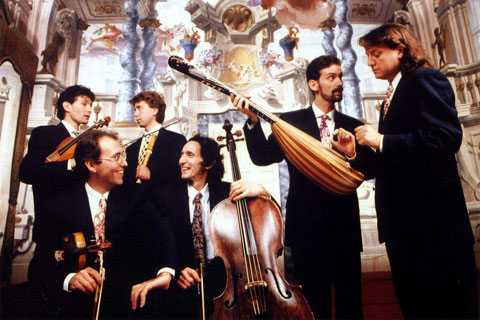
GARDEN PARTY There was no stage banter, and none was needed. |
They took the Sanders Theatre stage in silence, with all the authority of the Magnificent Seven. In their dark suits, they could have been Milanese bankers, except for the brightly colored ties (each different), puddling trousers, and full spectrum of hairstyles. They said not a word but went straight to their work, on a program of 17th- and 18th-century music from Venice, creating a kind of 25-minute suite of pieces by Dario Castello and Tarquino Merula before playing a sonata by Giovanni Legrenzi. Only then did their director, Giovanni Antonini, join them, for Vivaldi’s C-major concerto RV 444 for sopranino recorder, strings, and continuo.
Il Giardino Armonico were founded in Milan in 1985 and have been led by Antonini since 1989. Despite award-winning recordings of Bach’s Brandenburg Concertos and Vivaldi’s The Four Seasons and their Grammy-winning The Vivaldi Album collaboration with Cecilia Bartoli, they’re hardly household names — just like most of the composers they programmed last Saturday. But their Four Seasons is a kind of period-instrument landmark, high-spirited and theatrical, with vivid barking dogs and hallooing horns and thunder and lightning, Vivaldi’s masterpiece played as program music — which, after all, it is.
The line-up for their Boston Early Music Festival concert at a close-to-packed Sanders Theatre was Enrico Onofri (in black T-shirt and long white aviator scarf) and Marco Bianchi on violin, Stefano Barneschi on viola, Paolo Beschi on violoncello, Giancarlo De Frenza on double bass, Luca Pianca playing lute, and Riccardo Doni at the harpsichord, plus Antonini on treble and sopranino recorder. Beschi, Pianca, and Doni sat; the others stood, Onofri and Bianchi and Barneschi swaying like Lombardy poplars and sounding silky sweet for all their clarity and definition. Pianca’s lute solo introduced the Merula ciaccona, a play of violins (Barneschi sat, or rather stood, out) over the ground of the continuo instruments. The second Castello sonata interrupted its imitative frolicking with a poignant slow section; Pianca took it all out with a witty decrescendo.
That wasn’t an easy act to follow, but Antonini was up to it. Looking like a demented professor (or maybe a rock star) with his bushy hair and expressive eyebrows, he made his tiny recorder flit like a hummingbird and sing like a canary. In this and the other two Vivaldi concertos (RV 441 in C minor for treble recorder, RV 443 in C major for sopranino), you could feel the stillness inside Santa Maria Formosa, and the scurrying of pigeons in the Piazza San Marco, and the laziness of summer on the Lido (but with a hint of autumn), and water lapping everywhere in Vivaldi’s trademark spiccato fashion. A concerto by Baldassare Galuppi offered poignant distant views of the cemetery island of San Michele in its slow first movement and then a gondola chase, with first one instrument and then another swooping into the lead.
Thunderous applause and foot stomping ensured at least one encore. Antonini speaks! “Suoniamo bourrée di Telemann” or something like that, the sopranino intense throughout the dance. The second encore — no introduction this time — was a reprise of the Merulla ciaccona, now with Barneschi joining the continuo group. No third was offered, despite the audience’s best efforts.